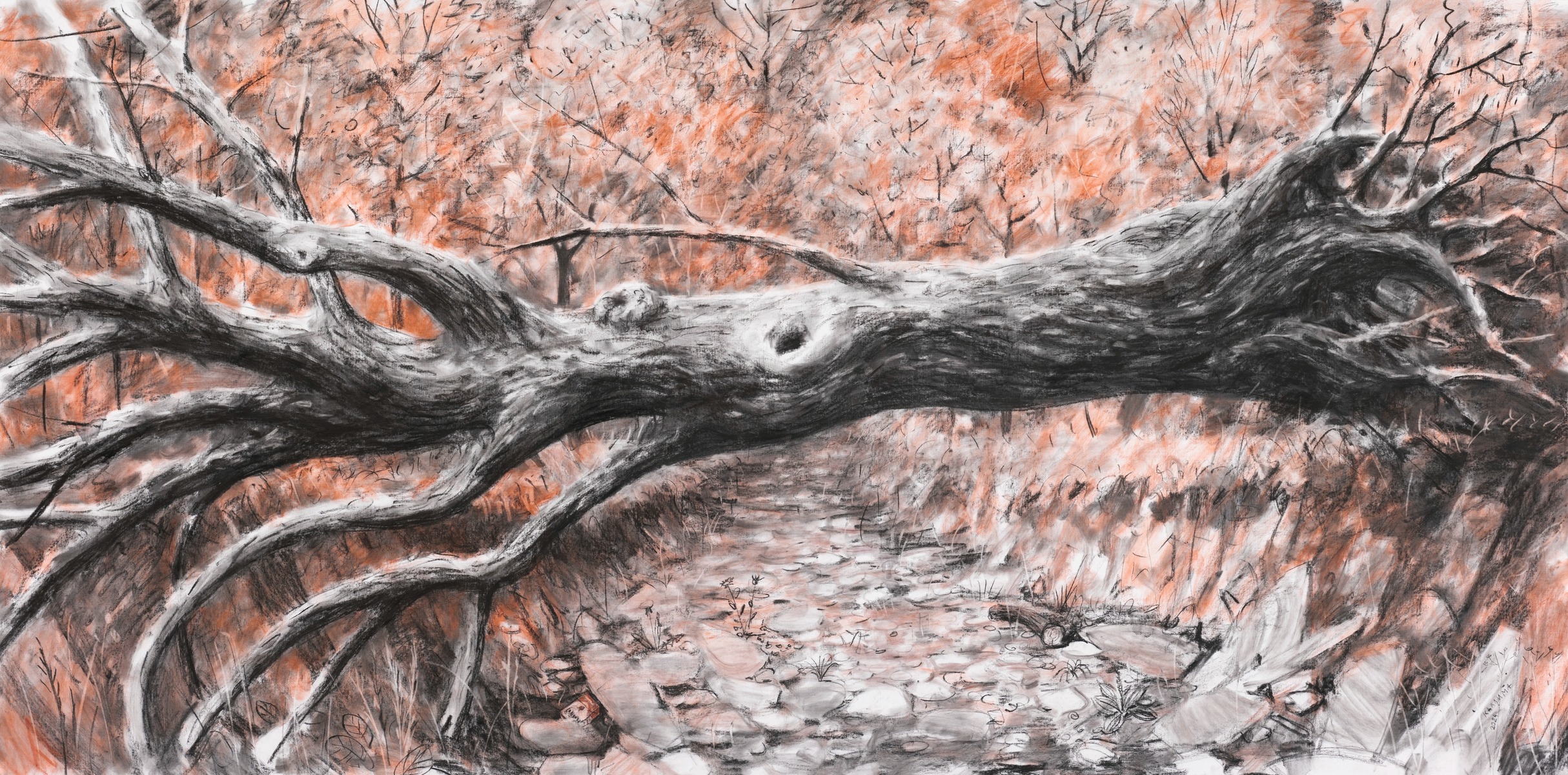



The current solo exhibition of Alexey Kallima at the VLADEY space can be seen as a new chapter in the evolution of his work over the past couple of years. A brief glance at his latest pieces immediately evokes the melancholic, enchanting qualities of his recent paintings from the "Region" project—meditative canvases, sparsely coloured, featuring nebulae in the middle zone, monotonous landscapes of swamps and forest-steppes. Kallima's paintings are characterized by lightness, shimmer, doubling, and fluidity. An abstract image before our eyes can suddenly transform into a distinct pattern—a sand ridge or mudflow facies—only to dissolve once more into a superficial pattern devoid of any direct connection to reality.
While his works lack rigidity and predetermination, they can still be compared to the works of Piet Mondrian in that the composition feels infinite, as if it could mentally stretch on endlessly, like a wet forest, the Ashe Delta, or a sandy beach. This is, of course, not about memories of vacations, tourism, or the usual sense of idleness and adventure; there is no canvas built on counterpoints typical of an archetypal hiking quest. The mood here is closer to the quiet solitude of walking alone in a place far removed from society and civilization. Some pieces resemble scans or casts of natural surfaces—skins of turf or bark—trophies from a distant forest. In this kind of escapism, there is a faint echo of mid-century retro—a time when, after the harshest trials, the natural version of existentialism, embodied by the GermanScandinavian forest of Ernst Jünger, emerged as a healing force for Europe. The forest became a nourishing soil, the foundation of a virtuous life, one that could also shelter partisans and outlaws. Jünger's forest represents a radical form of inner freedom, a spiritual brotherhood of loners, where the old romantic tradition is unmistakably present.
The Soviet interpretation of forest confrontation, as presented by Leonid Leonov, is somewhat simpler and "darker": it opposes bureaucratic careerism (the mainstay of socialist realism) to the natural "templarism" that contains echoes of devilry, paganism, and deep chthonic forces. Leonov's brilliant portrayal of the "Russian Forest" in Arkady and Boris Strugatsky's Snail on the Slope (1965) interprets the forest as an uncontrollable and unsupervised force, mobilized from within for self-development. Moreover, the nearby "Forestry Administration" is utterly incapable of predicting the future trajectory of this movement or even interacting meaningfully with the forest. The need for dialogue is perhaps the most significant new feature in the artist’s exploration of escapism into nature. In relation to his earlier works in The Region, something new is now emerging: the personalization of individual elements—let’s call them that. These elements are trees, a waterfall, the moon on a cloudy sky, and even a riverbed, which is visually and symbolically distinct from neighbouring surfaces—a kind of carpet of water that flows where it pleases. Singularities and outlined fragments characterize this second stage in Kallima’s development of the landscape theme.
A pivotal moment foreshadowing this new direction occurred in a single incident—an image of a large suspension bridge with a gap in the boards into which a small figure falls. This composition, in terms of the relationship between man and landscape, recalls The Fall of Icarus by Bruegel the Elder. However, Kallima does not substitute the noble work of the ploughman in Bruegel’s famous painting. The delicate perspective of the bridge is countered by the mighty flow of the river, and at the crossing, there is a moment of confusion (or tragedy?). But it is precisely through this opposition to man that the landscape takes on distinct, individual characteristics. It should be noted that the postman figure in Kallima’s landscapes plays a role in the philosophy of the project as significant as Icarus's legs twitching in the water in the seascape. In both cases, the focus is on the diminishment or exaggeration of the dramatic hero and the cause they serve. Who would still need letters today, even from a deceased person or a colonel to whom no one writes, even if the postman comes twice? Solitude and silence—this is what the artist offers to those who hunger for news, those who depend on it, those fully immersed in it. And also—a path through a dark forest, another bridge, not leading outward, but inward—into the forest, into oneself. For, at a time when the bridge has collapsed, the return to nature, which seemed abandoned in the distant sixties, carries more humanism and practical significance than ever before.






К сожалению, браузер, которым вы пользуйтесь, устарел и не позволяет корректно отображать сайт. Пожалуйста, установите любой из современных браузеров, например:
Google Chrome Firefox Opera